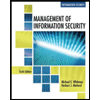
Concept explainers
Explanation of Solution
Business intelligence and Business analytics:
Business intelligence refers to technologies, applications, infrastructures and tools that performance a main role in the planning process of the corporation.
- The set-up for analyzing data, reporting, warehousing and combining data from the business atmosphere.
- It gathers, stores, clean and makes appropriate data offered to managers. It consist of databases, data warehouses, and data markets...
Explanation of Solution
Elements of a Business intelligence environment:
- 1) Data from the business environment:
Different sources of organized and unorganized data, Internet and mobile devices are combined and used by the people decision makers.
- 2) Business intelligence infrastructure:
Strong
- 3) Business analytics tools:
Software tools used to examine data and send respond, reports to manager queries and use key pointers of presentation to follow a business growth...
Explanation of Solution
Analytic functionalities provided by Business intelligence systems:
- 1) Production reports
The predefined reports are constructed on business agree requirements.
- 2) Parameterized reports
An Operators enter numerous constraints in a pivot table to screen data and separate effects of the constraints.
- 3) Dashboards and scorecards
Visual tools is used to presenting records as created by users...
Explanation of Solution
Predictive analytics and location analytics with examples:
Predictive analytics is defined as an extracting data from existing data sets which is used for analysis of statistics, mining and for upcoming expectations to forecast future developments and performance designs. It comprises the skill to develop the future actions and performance for past events.
Two examples of Predictive analytics:
- 1) Predict age, gender, location and driving records in insurance policy companies to begin appropriate cost of plans.
- 2) Predict the customer response to the product depends on offers in the product by the retailers...
Explanation of Solution
Types of Business intelligence users:
- 1) Power users
Nearly 20 percent of employees in the groups of business analysts, IT developers, analytical modelers and super users who producing new analyses, models, reports and forecasts.
- 2) Casual users
Other 80 percent...
Explanation of Solution
Balanced scorecard method and business performance management:
Balanced scorecard method:
A senior manager can create the outline for operating a secure plan by concentrating on computable results on four views of the performance of organizations. They are business process, customer, financial, growth and learning. This method helps to increase the customer satisfaction, business process efficiency and improvement in the employee activities...
Want to see the full answer?
Check out a sample textbook solution
- Find the Error: class Pet def __init__(self, name, animal_type, age) self.__name = name; self.__animal_type = animal_type self.__age = age def set_name(self, name) self.__name = name def set_animal_type(self, animal_type) self.__animal_type = animal_typearrow_forwardTask 2: Comparable Interface and Record (10 Points) 1. You are tasked with creating a Java record of Dog (UML is shown below). The dog record should include the dog's name, breed, age, and weight. You are required to implement the Comparable interface for the Dog record so that you can sort the records based on the dogs' ages. Create a Java record named Dog.java. name: String breed: String age: int weight: double + toString(): String > Dog + compareTo(otherDog: Dog): int > Comparable 2. In the Dog record, establish a main method and proceed to generate an array named dogList containing three Dog objects, each with the following attributes: Dog1: name: "Buddy", breed: "Labrador Retriever", age: 5, weight: 25.5 Dog2: name: "Max", breed: "Golden Retriever", age: 3, weight: 30 Dog3: name: "Charlie", breed: "German Shepherd", age: 2, weight: 22 3. Print the dogs in dogList before sorting the dogList by age. (Please check the example output for the format). • 4. Sort the dogList using…arrow_forwardThe OSI (Open Systems Interconnection) model is a conceptual framework that standardises the functions of a telecommunication or computing system into seven distinct layers, facilitating communication and interoperability between diverse network protocols and technologies. Discuss the OSI model's physical layer specifications when designing the physical network infrastructure for a new office.arrow_forward
- In a network, information about how to reach other IP networks or hosts is stored in a device's routing table. Each entry in the routing table provides a specific path to a destination, enabling the router to forward data efficiently across the network. The routing table contains key parameters determining the available routes and how traffic is directed toward its destination. Briefly explain the main parameters that define a routing entry.arrow_forwardYou are troubleshooting a network issue where an employee's computer cannot connect to the corporate network. The computer is connected to the network via an Ethernet cable that runs to a switch. Suspecting a possible layer 1 or layer 2 problem, you decide to check the LED status indicators on both the computer's NIC and the corresponding port on the switch. Describe five LED link states and discuss what each indicates to you as a network technician.arrow_forwardYou are a network expert tasked with upgrading the network infrastructure for a growing company expanding its operations across multiple floors. The new network setup needs to support increased traffic and future scalability and provide flexibility for network management. The company is looking to implement Ethernet switches to connect various devices, including workstations, printers, and IP cameras. As part of your task, you must select the appropriate types of Ethernet switches to meet the company's needs. Evaluate the general Ethernet switch categories you would consider for this project, including their features and how they differ.arrow_forward
- You are managing a Small Office Home Office (SOHO) network connected to the Internet via a fibre link provided by your Internet Service Provider (ISP). Recently, you have noticed a significant decrease in Internet speed, and after contacting your ISP, they confirmed that no issues exist on their end. Considering that the problem may lie within your local setup, identify three potential causes of the slow Internet connection, focusing on physical factors affecting the fibre equipment.arrow_forwardYour organisation has recently installed a new network in a building it has acquired. As the network administrator, you have set up a dedicated telecommunications room to house all the rack-mounted servers, switches, and routers. To ensure optimal performance and longevity of the equipment, you need to monitor certain environmental factors in the room. Identify the environmental factors that should be monitored and explain why each is important to maintain the proper functioning of the telecommunications equipment.arrow_forwardYour organisation is preparing to move into a newly constructed office building that has never been occupied or wired for network services. As the network administrator, your manager has tasked you with designing a structured cabling plan that will support data, voice, and other network services across all building floors. The cabling plan must account for future expansion, efficient data transmission, and compliance with industry standards. Identify and explain the different subsystems you would include in the structured cabling scheme, following the ANSI/TIA/EIA 568 standard.arrow_forward
- As a technical advisor responsible for designing a network in a newly constructed building, you have decided to utilise twisted pair cables to efficiently deliver data and voice services. Given the specific requirements for connectivity in this setup, identify the appropriate connector types that can be used with twisted pair cables, explaining how each connector works in detail.arrow_forwardIn computer networks, communication between devices or nodes relies on predefined rules known as network protocols. These protocols ensure that data can be transmitted accurately and efficiently between different devices, even on separate networks or running different operating systems. Explain how a network protocol facilitates the transmission of data between nodes.arrow_forwardYou are part of the IT department at a large company, tasked with setting up a new branch office's networking infrastructure. The branch office must handle various types of traffic, including video conferencing, file sharing, and cloudbased business applications. The network will also need to prioritise certain types of traffic to ensure smooth video conferencing and efficient application performance. Due to budget constraints, the company plans to use physical and virtual systems to set up the network, balancing the cost and performance needs. Describe how you would approach the design and implementation of the networking infrastructure for this new branch office, ensuring it meets the company's needs for efficient application performance and traffic prioritisation.arrow_forward
 Principles of Information Systems (MindTap Course...Computer ScienceISBN:9781305971776Author:Ralph Stair, George ReynoldsPublisher:Cengage Learning
Principles of Information Systems (MindTap Course...Computer ScienceISBN:9781305971776Author:Ralph Stair, George ReynoldsPublisher:Cengage Learning Fundamentals of Information SystemsComputer ScienceISBN:9781337097536Author:Ralph Stair, George ReynoldsPublisher:Cengage Learning
Fundamentals of Information SystemsComputer ScienceISBN:9781337097536Author:Ralph Stair, George ReynoldsPublisher:Cengage Learning Management Of Information SecurityComputer ScienceISBN:9781337405713Author:WHITMAN, Michael.Publisher:Cengage Learning,
Management Of Information SecurityComputer ScienceISBN:9781337405713Author:WHITMAN, Michael.Publisher:Cengage Learning, Fundamentals of Information SystemsComputer ScienceISBN:9781305082168Author:Ralph Stair, George ReynoldsPublisher:Cengage Learning
Fundamentals of Information SystemsComputer ScienceISBN:9781305082168Author:Ralph Stair, George ReynoldsPublisher:Cengage Learning Database Systems: Design, Implementation, & Manag...Computer ScienceISBN:9781305627482Author:Carlos Coronel, Steven MorrisPublisher:Cengage Learning
Database Systems: Design, Implementation, & Manag...Computer ScienceISBN:9781305627482Author:Carlos Coronel, Steven MorrisPublisher:Cengage Learning





